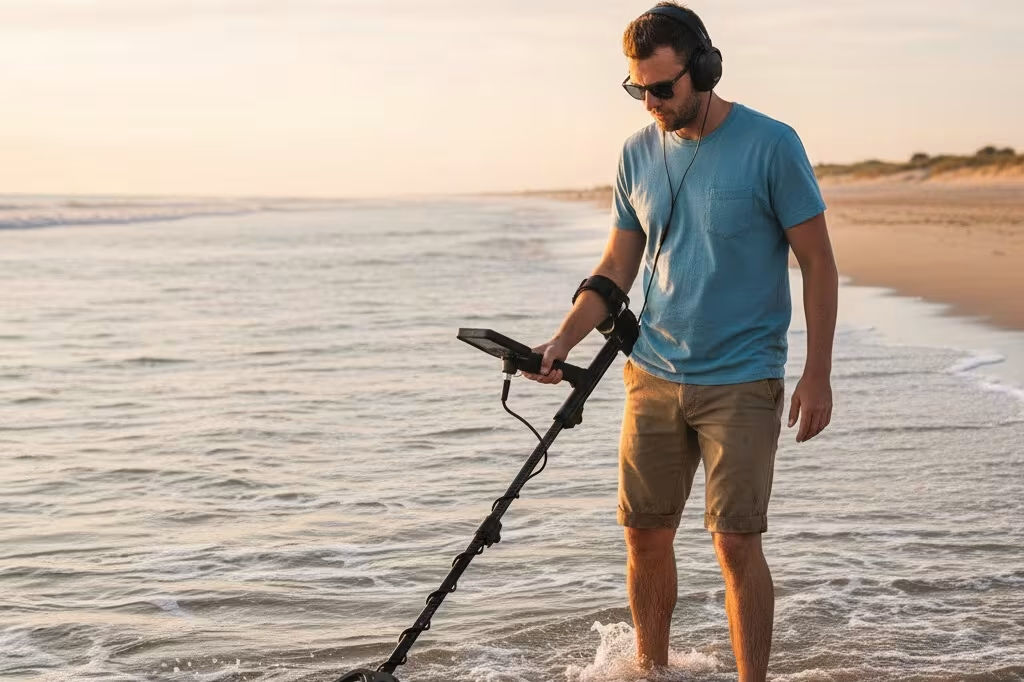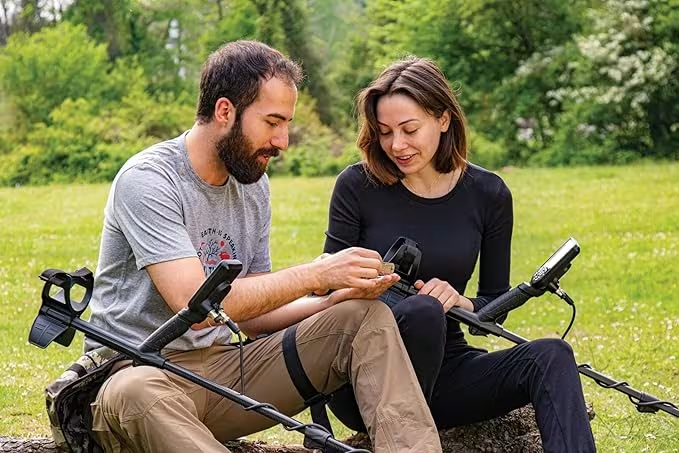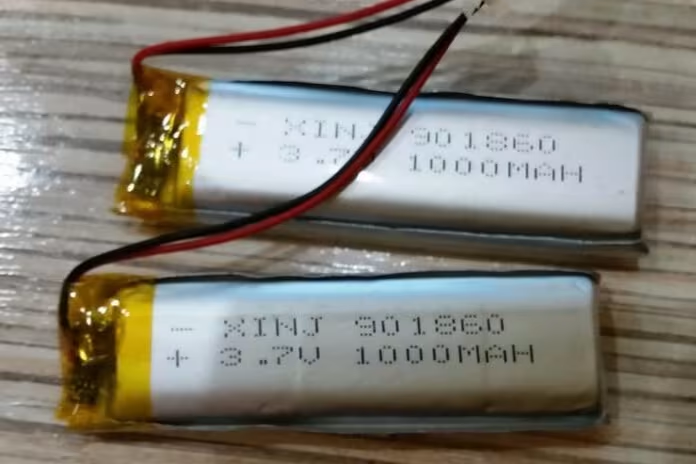Three months ago, I watched something that changed everything about how I think about metal detector value.
A guy pulled a 1943 Mercury dime from nine inches down at my local park. He was using a $349 detector, fully submerged in the surf on a beach hunt. Meanwhile, I stood there with my $800 single-frequency machine that couldn’t even handle the wet sand without throwing false signals every three seconds.
That detector was the Nokta Double Score, and that moment made me rethink everything.
Here’s what nobody tells you when you’re shopping for your first multi-frequency detector: the old rules don’t apply anymore. For years, you had to spend $1,000 or more to get simultaneous multi-frequency (SMF) technology—the kind that crushes beach hunting and handles mineralized soil like it’s nothing. Nokta destroyed that assumption by releasing the Score series at $279 to $499, bringing professional-grade detection capability to prices most of us can actually afford.
But here’s the catch. Nokta made three different models, and choosing wrong means you’ll either overpay for features you’ll never use or quickly outgrow a detector that lacks the controls you’ll desperately want six months from now.
Let me save you from making an expensive mistake.
- What Makes the Nokta Score Series Different: Multi-Frequency Technology Explained
- Nokta Score Review ($279-349): Best Entry-Level Multi-Frequency Detector?
- Nokta Double Score Review ($349-399): The Best Value Metal Detector for Most Detectorists
- Nokta Triple Score Pro Pack Review ($479-499): Professional Metal Detecting Features on a Budget
- Nokta Score vs Minelab Vanquish vs Garrett ACE: Metal Detector Comparison
- Which Nokta Score Model Should You Buy? Final Recommendations
- References
What Makes the Nokta Score Series Different: Multi-Frequency Technology Explained
Before we dive into which model to buy, let’s talk about why this series matters in the first place.
The Score lineup shares one revolutionary feature: simultaneous multi-frequency technology that transmits multiple frequencies at once instead of switching between them. In plain English, your detector can handle saltwater beaches, iron-infested historic sites, and heavily mineralized soil without breaking a sweat.
Compare that to traditional single-frequency detectors in the $300-400 range. Those machines choke on wet beach sand and can’t tell a coin from a rusty nail when they’re buried six inches apart. I learned this the hard way at a Colonial-era site outside Philadelphia when my single-frequency detector kept falsing on iron fragments and missing good targets completely. My friend with an older Nokta multi-frequency machine? He was digging buttons and buckles all afternoon while I was getting nothing but frustration.
All three Score models share this same SMF core technology, plus some legitimately impressive specs that hold true across the lineup:
- IP68 waterproofing to 16 feet (full submersion, not just splashproof)
- 12-hour battery life (actual detecting time, not inflated manufacturer claims)
- Carbon fiber shaft (light enough for all-day hunts without your arm falling off)
- 12″ x 9″ search coil (larger than most competitors at this price point)
So if they all share the same detection engine, why three models? The answer lies in how much control you want when you’re actually in the field—and more importantly, how much control you actually need for the kind of detecting you’ll be doing.
Nokta Score Review ($279-349): Best Entry-Level Multi-Frequency Detector?

The base Score is Nokta’s price leader, and I’ll be blunt about this: it’s designed to get you in the door, not necessarily to keep you happy long-term.
What you get: Automatic everything. Ground balance? Automatic. Recovery speed? Fixed. Discrimination patterns? Pre-programmed. For someone who’s never held a metal detector before, this sounds perfect—just turn it on and start swinging.
What you don’t get: Manual ground balance adjustment and recovery speed control. These aren’t luxury features; they’re fundamental tools for handling difficult detecting environments.
I watched this play out at a Revolutionary War campsite that’s been heavily hunted over the years. My buddy bought the base Score to save $70, figuring he’d learn on it first. Within two weeks, he was asking to borrow my detector because his kept chattering over mineralized ground and couldn’t separate targets in the trashy areas where all the good finds hide. The brutal truth from forums backs this up—one detectorist noted that you can’t manually ground balance the base Score, which handicaps it in many common detecting environments. Another asked within days of purchase whether they’d regret not getting the Double Score’s additional controls.
Who should buy the base Score: Pure beginners hunting exclusively clean parks and beaches, who absolutely need the lowest possible entry price and accept they might upgrade within a year.
Who shouldn’t: Anyone serious about the hobby, anyone hunting iron-contaminated sites, or anyone who wants to grow their skills beyond absolute basics.
Nokta Double Score Review ($349-399): The Best Value Metal Detector for Most Detectorists
After testing all three models and talking to dozens of detectorists, I’m convinced the Double Score represents the optimal value for 80% of buyers. Here’s why.
The $70-120 upgrade over the base Score buys you three game-changing capabilities:
1. Three recovery speed settings instead of none. Recovery speed determines how quickly your detector processes targets, which directly impacts whether you can separate a coin from adjacent trash. In moderately trashy parks—basically everywhere people have been for the last 100 years—this makes all the difference between finding coins and walking away frustrated.
2. Ground balance options including manual adjustment. Different soil has different mineralization levels, and while automatic ground balance works fine in average conditions, manual adjustment keeps your detector stable when you hit challenging ground. It also extends your effective depth, which translates directly to older, deeper finds.
3. Iron audio filtering with adjustable settings. This lets you hear what type of trash you’re detecting without rejecting potentially good targets completely. More importantly, it helps you learn to recognize iron false signals—a skill that compounds over time and makes you a better detectorist.
One 20-year veteran sold his $1,600 XP Deus 2 and switched to the Double Score, posting this in a forum: “I get sick and tired of hearing them say good entry level or newbie detector more BS! Just because of its price it’s not considered as good as a 1,600.00 detector”[4]. His point? The Double Score delivers 90% of the performance at 25% of the price, which is exactly what most of us actually need.
Real-world depth performance backs this up. Independent testing buried copper coins at 15cm, 20cm, and 25cm depths, and the Score series detected at these ranges with stable target ID—performance matching detectors costing twice as much. The multi-frequency mode maintained target ID readings of 34-35 across all depths, while switching to single-frequency mode caused problems with ID drift from 35 to 50+ at maximum depth.
To put this in perspective: entry-level single-frequency detectors typically deliver 2-6 inches on coin-sized targets, mid-range machines reach 8-16 inches, and the Score series comfortably hits that mid-range benchmark.
Who should buy the Double Score: Nearly everyone reading this article. Beginners who want room to grow, experienced detectorists looking for a value-packed backup or water machine, and anyone hunting varied terrain who needs real control over their settings.
Nokta Triple Score Pro Pack Review ($479-499): Professional Metal Detecting Features on a Budget

The Triple Score is where Nokta stopped holding back and built a detector for serious hobbyists and experienced detectorists. The price jump to $479-499 is substantial, but you’re getting capabilities that typically cost $1,000 or more.
Key upgrades that matter in the field:
Five recovery speed settings instead of three. This granular control lets you fine-tune target separation for extremely trashy sites like old fairgrounds, picnic areas under metal bleachers, or battlefield relics in iron-saturated soil. One forum user noted they could unmask targets in heavily contaminated sites that their previous detector completely missed.
Selectable frequency operation (5kHz, 10kHz, 15kHz, 20kHz) plus SMF mode. This opens tactical advantages for the technically-minded detectorist: lower frequencies (5-10kHz) excel at high-conductivity targets like large silver, while higher frequencies (15-20kHz) maximize sensitivity to small gold and thin coins. You can experiment with frequency selection based on target type and ground conditions, which is the kind of control that usually costs way more.
Advanced audio customization with tone break adjustments. Relic hunters and experienced detectorists often rely on subtle audio cues to make dig decisions, and the Triple Score lets you configure audio response to match your hunting style and preferences.
Included accessories that justify the price. The Pro Pack bundles Bluetooth headphones (no annoying wires while digging) and a secondary 9.5″ x 6″ coil worth $150-200 separately. That smaller coil excels in tight spaces and trashy areas where the standard 12″ coil struggles with target separation, giving you tactical flexibility right out of the box.
Joan Allen’s UK review nailed the Triple Score’s position: “I do recommend the Nokta Triple Score as an outstanding entry to intermediate level detector… truly remarkable value”[10]. Note “entry to intermediate”—this isn’t overkill for newer detectorists who are serious about the hobby and plan to stick with it.
Who should buy the Triple Score: Experienced detectorists upgrading from older technology, relic hunters tackling iron-contaminated historic sites, serious hobbyists who will immediately benefit from professional-grade features, or anyone who wants maximum versatility without spending $1,500 or more.
Who shouldn’t: Pure beginners who will be overwhelmed by options, or budget-conscious hunters whose detecting sites don’t demand this level of control.
Nokta Score vs Minelab Vanquish vs Garrett ACE: Metal Detector Comparison

Let’s get real about the competitive landscape, because context matters when you’re spending $300-500 on a detector.
Minelab Vanquish 540 ($399-449): This is the Score series’ closest competitor, offering Multi-IQ (Minelab’s version of SMF) at similar prices. Depth performance is comparable—both achieve 10-12+ inches on coin-sized targets. The critical difference? Only the Vanquish’s coil is waterproof, not the control box. The Score series offers full submersion to 16 feet, which matters enormously if you plan to wade into surf or creeks.
Garrett ACE 300/400 ($279-349): Single-frequency technology that’s fundamentally obsolete for saltwater or heavily mineralized environments. The ACE 300 maxes out around 8 inches depth, and neither model can handle wet beach sand effectively. At the same price point, there’s simply no reason to choose outdated technology when you can get multi-frequency capability.
Fisher F44 ($299-349): Better than the Garrett options but still hobbled by single-frequency operation. Air tests show 9-12 inches depth, but real-world performance drops to 5-6 inches practical recovery depth. Again, why accept single-frequency limitations when SMF is available at the same price?
The market dynamics are clear. Nokta forced a paradigm shift by delivering multi-frequency capability at prices where single-frequency used to dominate. Every other manufacturer has had to respond, and most still can’t match the Score series’ price-to-performance ratio without making compromises somewhere else.
DetectorForMetal Exclusive: Nokta Legend vs Minelab Equinox 900.
Which Nokta Score Model Should You Buy? Final Recommendations

After spending months watching the Score series in action, here’s my bottom-line guidance.
After reading hundreds of user experiences. After talking to detectorists at all skill levels.
Buy the Double Score if:
You’re a beginner who wants to actually learn the hobby. Not just mess around at the beach twice a year.
You’re an experienced detectorist looking for a value-packed backup. Or a dedicated water machine.
You hunt varied terrain and need essential control features.
This is the model I’d buy for myself. And did.
Buy the base Score if:
You’re genuinely unsure whether metal detecting will stick as a hobby. You need the absolute lowest entry price.
You hunt exclusively clean beaches or well-maintained parks.
Just know you’re accepting real limitations. You may upgrade within a year.
Buy the Triple Score if: You’re serious about relic hunting or tackling challenging historic sites. You’re upgrading from older technology and will immediately put those advanced features to use. You value having two coils and Bluetooth headphones included right out of the box, and you’re confident this hobby is long-term for you.
For 70% of readers, the Double Score is the right choice. It bridges the gap between beginner-friendly simplicity and genuine capability, delivering controls you’ll use constantly rather than luxury features that gather dust in your closet.
One forum post summarized it perfectly. After selling his expensive detector, a veteran wrote: “The Double Score is my multi frequency Simplex I’ve been wanting—easier, simple, no fiddling around with settings” while still delivering all the performance he needed[4].
The Score series proves something important: you don’t need to spend $1,500 to find old coins and artifacts. You just need to choose the right model for your detecting reality—not the marketing fantasy of treasure hunting every weekend or the false economy of buying the cheapest option that won’t do what you need.
And hey, if you see someone at the beach with their detector three feet underwater pulling up rings and coins? That might just be me with my Double Score, finally understanding that value isn’t about the price tag—it’s about whether the machine actually does the job you need it to do.
Happy hunting! 🏆
References
[1] Nokta Detectors. “Nokta Score.” Nokta Detectors Official Website. https://www.noktadetectors.com/metal-detector/score/
[2] Serious Detecting. “Comprehensive Comparison of Nokta Score, Double Score, and Triple Score Metal Detectors: Features and Specifications.” https://seriousdetecting.com/blogs/metal-detector-comparison-guides/comprehensive-comparison-of-nokta-score-double-score-and-triple-score-metal-detectors-features-and-specifications
[3] Nokta Detectors. “Nokta Double Score.” Nokta Detectors Official Website. https://www.noktadetectors.com/metal-detector/double-score/
[4] Find’s Treasure Forums. “I Think I Finally Found It – Nokta Double Score.” https://www.findmall.com/threads/i-think-i-finally-found-it-nokta-double-score.379600/
[5] Friendly Metal Detecting Forum. “Nokta Double or Triple Score.” https://metaldetectingforum.com/index.php?threads/nokta-double-or-triple-score.311097/
[6] LovecPokladu.cz. “How to Nokta Score Metal Detectors Part One Score.” https://www.lovecpokladu.cz/en/home/how-to-nokta-score-metal-detectors-part-one-score-10146
[7] DetectHistory. “Garrett ACE 300 Review.” https://detecthistory.com/reviews/garrett-ace-300-review/
[8] Nokta Detectors. “Nokta Triple Score Pro Pack.” Nokta Detectors Official Website. https://www.noktadetectors.com/metal-detector/triple-score-pro-pack/
[9] Find’s Treasure Forums. “Tried Out My New Nokta Triple Score.” https://www.findmall.com/threads/tried-out-my-new-nokta-triple-score.380922/
[10] Joan Allen UK. “Nokta Triple Score Review.” https://www.joanallen.co.uk/nokta-triple-score-review

My name is Paul and I am the founder of Detector For Metal, a dedicated resource for metal detecting enthusiasts seeking to uncover historical treasures and connect with the past using the latest technology. As a stay-at-home dad and family man, I’ve found metal detecting to be the perfect hobby that combines family adventure with historical learnings for the whole family.
As a father, I’m deeply committed to passing on this hobby to the next generation of detectorists, starting with my own children. I share advice on everything from metal detecting with kids to exploring the top 10 metal detecting sites you never thought about. My methodical approach to the hobby goes beyond the thrill of discovery—it’s about creating family traditions while preserving history and sharing the stories of those who came before us.


